Looking back
Tutenkhamun
Fact file
* Even though Tutenkamun did not expand Egypt's borders or enjoy
triumphant victories like most other pharaohs before his
|
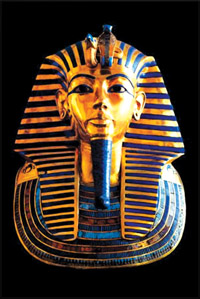
The golden mask. |
time, he is one
of the most famous pharaohs of the Egyptian Empire.
* He relocated his capital to Memphis and Thebes.
* The Boy King was the 12th king of the 18th Egyptian dynasty and
reigned from 1361-1352 B.C.E.
* He was a trained archer.
* His burial rituals are said to have lasted 70 days and his
grandfather is believed to have been involved prominently in the
rituals. A scene depicting the 'opening of the mouth ceremony' found in
Tutenkhamun's burial chamber features Ay prominently.
The 'opening of the mouth' ceremony is carried out to restore the
senses to the deceased as Egyptians strongly believed in afterlife.
* Tutenkhamun did not leave behind any children, but Mumified female
foetuses had been discovered in his tomb.
* As mystery still surrounds his death (despite all the CT scans done
on the mummy) some researchers claim he was murdered violently.
* His tomb is designated as KV 62 in the Valley of the Kings where
the pharaohs were usually buried.
* He is the only pharaoh to be given a nickname in popular culture -
King Tut.
* Lord Carnarvon was a rich man who had the right to dig in the
Valley of the Kings.
* It took some 10 years for Howard Carter to finish excavating the
tomb.
***
Egypt's Boy King still held in awe
He lived and died more than 3,000 years ago, during the time of
Egypt's New Kingdom, but the world is still fascinated by the life
history of this young pharaoh - the Boy King.
|

Howard Carter |
Even though he accomplished very little during his short reign,
Tutenkhamun is one of the most recognised and popular pharaohs of
ancient Egypt. In fact, the recent unveiling of his mummified face (see
page 19) has kindled more interest in tracing the pharaoh's life. So we
thought of taking you back in time to enlighten you about 'King Tut' as
he is popularly called today ...
Just as much as his life and death is shrouded in mystery, there is
mystery surrounding his birth too, especially his parentage. Historians
say that Amenhotep IV, who changed his name to Akhenaten (servant of the
Aten) following his religious beliefs, was the father of Tutenkhamun.
However, Queen Nefertiti, the chief wife of King Akhenaten who bore
the king six daughters is not the mother. It is believed that a lesser
wife known as Kiya is the mother.
At birth, the boy was named Tutankhaten, in accordance with the name
of the sun god Aten, the parents worshipped. Not
|
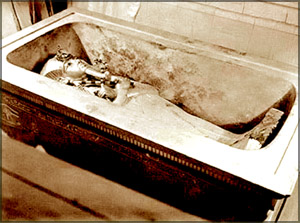
King Tutís coffin in his sarcophagus |
much records are
available about his early life, but historians say that he too would
have spent his childhood in his father's palace, learning all the skills
any royal child would have been taught at that time.
When and how did a child aged just nine years end up ruling such a
powerful empire like Egypt, is indeed interesting.
Even though the exact date when the Boy King, as he was called, was
enthroned is not evident, records show that he took over the reign after
the deaths of his father Akhenaten, and a shadowy figure named
Smenkhkare, (perhaps a brother or relative of King Akhenaten), who was
closely associated with the king during his rule.
However, when the little boy took over the reigns of Egypt, he
inherited a chaotic state filled with a lot of angry people.
This was due to King Akhenaten's religious beliefs - the worshipping
of one god, the sun god named Aten, discarding all the other ancient
Egyptian gods worshipped by the people prior to his reign.
In order to win back the angry priests and the people, the Boy King
is said to have moved away from the religious cult
|

Painted walls in the burial chamber |
(following) of his
parents and reintroduced the worship of the ancient Egyptian gods,
especially Amun.
Measures had been taken to restore the temples of Amun to the glory
they enjoyed prior to the times of his father and Queen Neferfiti.
When reading this, one question that would naturally come to your
mind is 'how could such a small boy take such important and decisive
decisions to govern such a powerful empire? Well, obviously he had the
assistance of his elders; two high officials who figure prominently in
this respect are Ay (believed to be the father of Queen Neferfiti) and
Horenheb, commander-in-chief of the army.
Perhaps, it is they who initiated the Boy King's marriage to his
half-sister, Ankhesenpaaten at the age of nine. His half-sister was only
slightly older to him. After marriage both had changed their names from
Tutenkhaten (gracious life of Aten or living image of Aten) to
Tutenkhamun (also written as Tutenkhamen or Tutenkhamon), and
Ankhesenpaaten to Ankkhesenamun to reflect the return to favour of the
hierarchy of Amun, in keeping with the religions followed by them.
Tutenkhamun, which is derived from the hieroglyphics Tut-ankh-amun,
when translated is said to mean 'living image of Amun'. No one really
knows how exactly the name was pronounced in ancient times.
|
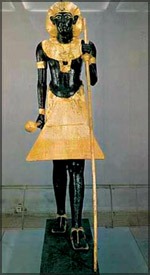
Life size wooden statue of the king. |
|
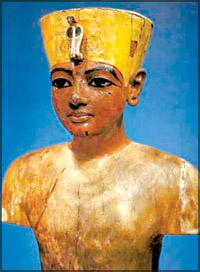
Painted wooden torso of the king. |
But, no matter how it is pronounced, it is no doubt one of the most
powerful names in Egyptian history which continues to hold the world in
awe, even after so many years, especially since the discovery of his
tomb.
It was on November 4, 1922, that a British Egyptologist named Howard
Carter working for Lord Carnarvon made the historic discovery of the Boy
King's tomb, virtually undisturbed, in the Valley of the Kings where all
the Egyptian pharaohs were buried.
By this time, it was believed that most of the tombs had been already
discovered and even if there were ones yet to be discovered, they would
be completely plundered by treasure hunters.
Finding the tomb of Tutenkhamun with his mummy in tact, along with
the treasure was indeed considered one of the greatest discoveries of
the century. What was found in the tomb dazzled the world and kindled a
new interest in the young pharaoh who died mysteriously at 18 or 19
years of age.
Tutenkhamun died in the ninth year of his reign. It was firmly
believed up until the discovery of the mummified body of Tutenkhamun,
that the young pharaoh was murdered perhaps because, after his sudden
and mysterious death at a time when Egypt was in battle with the
Hittities, his maternal grandfather (and also father-in-law)took over
and ruled Egypt for four years.
|
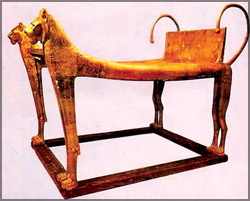
A funery bed in the form of a lion |
|

The coffin made of solid gold |
The ageing Ay even married Tutenkhamun's wife. It is said that the
Boy King's tomb not only opened up a world of treasure, but a new
insight into the lifestyle of Egyptian royalty and King Tut's life at
that time. Even though the tomb was obviously not designed originally
for the Boy King (as it is considered rather small when compared to
those built for other pharaohs), the tomb had been modified for the Boy
King's burial.
The treasure chamber, adjacent (next) to the burial chamber, had
contained many valuable treasures and all the necessary 'equipment' for
his afterlife. Some of the things found in the tomb (both burial chamber
and treasure chamber) are his throne chair.
A silver trumpet, sarcophagus symbols, boats, gilded figures, canopic
chests containing internal organs and four gilded images of goddesses.
Many of those items are now in museums. However, the Boy King's mummy is
still in its underground tomb in the Valley of the Kings in Egypt.
The mummy had been deposited inside three coffins which were also
inside a stone sarcophagus. This too had been inside four gilded shrines
nestled one inside the other (the innermost being the stone
sarcophagus).
Would you believe that the coffin containing the mummified body of
the pharaoh had been made of 110 kg of solid gold? Even his face mask is
said to have been made of gold, and is strikingly beautiful.
Many theories about the cause of his death were debunked (proved as
false), once scientists carried out research on the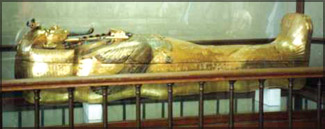 mummy. However,
tests had revealed that the Boy King had sustained trauma to the head,
and also a fracture of the left femur (thigh-bone) with broken skin. mummy. However,
tests had revealed that the Boy King had sustained trauma to the head,
and also a fracture of the left femur (thigh-bone) with broken skin.
They are attributed to a fall from a chariot or injuries sustained
during battle. The fact that many walking sticks had been found in the
tomb clearly indicates that Tutenkhamun was either a sickly child or had
some difficulty in walking.
Even though the world was enthralled by the discovery of the tomb
with King Tut's mummy and all the treasures, many fascinating stories
floated around about a curse on those who disturbed the tomb. It was
further fuelled by Lord Carnarvon's death on April 5, 1923, seven weeks
after the official opening of the burial chamber.
Arthur Conan Doyle (creator of the famous Sherlock Holmes), who
believed in the occult, had announced that the death could be a result
of a curse by the pharaoh. It was also reported that Howard Carter's pet
canary was swallowed by a cobra on the day the tomb was opened.
So, any misfortune or death of those involved in the opening of the
tomb (26 are said to have been present) was linked to the curse by those
who strongly believed in it, and even claimed that an inscription
stating 'Death shall come on swift wings to him that disturbs the peace
of the King" was present in the tomb. However, no such inscription has
been discovered so far.
Whether or not the curse is real or just a legend, research into King
Tut's life and his historic tomb still continues. The unveiling of his
mummified face has only sparked more interest in the Boy King.
Facts and pix: Internet - English
Wikipedia |
